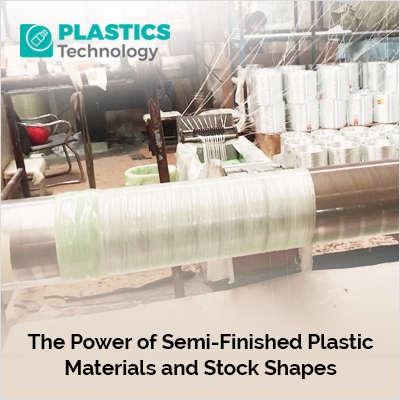The Power of Semi-Finished Plastic Materials and Stock Shapes

I. Introduction:
Semi-finished plastic materials and stock shapes play a pivotal role in various industries, revolutionizing the way products are designed, manufactured, and utilized. These versatile materials offer a plethora of benefits, from enhanced durability and flexibility to cost-effectiveness and environmental sustainability. In this article, we delve into the power of semi-finished plastic materials and stock shapes, exploring their key attributes, applications across industries, and the future trends shaping their evolution.
II. Understanding Semi-Finished Plastic Materials:
Semi-finished plastic materials are raw forms of plastics that undergo processing to create stock shapes such as sheets, rods, tubes, and profiles. These materials are derived from polymers like polyethylene (PE), polypropylene (PP), polystyrene (PS), polyvinyl chloride (PVC), and more. The manufacturing process involves extrusion, injection molding, or compression molding, resulting in uniform shapes with consistent properties.
| Also Read: Exploring Semi-Finished Plastics in Manufacturing |
III. Key Attributes and Advantages:
Versatility: Semi-finished plastic materials come in a wide range of types, colors, and sizes, making them suitable for diverse applications across industries such as automotive, aerospace, construction, healthcare, and packaging.
Durability: Plastics offer excellent resistance to corrosion, chemicals, moisture, and wear, ensuring long-term performance and reliability in challenging environments.
Lightweight: Compared to traditional materials like metal, plastics are lightweight yet strong, contributing to fuel efficiency in transportation and ease of handling in various applications.
Flexibility: Plastics can be molded into complex shapes, allowing for intricate designs and customization to meet specific project requirements.
Cost-Effectiveness: Semi-finished plastic materials are often more affordable than alternatives like metal or wood, leading to cost savings in production and maintenance.
Sustainability: Many plastics are recyclable and contribute to sustainable practices, reducing waste and environmental impact when managed responsibly.
IV. Applications across Industries:
Automotive: Semi-finished plastic materials are used in automotive interiors, exteriors, and components due to their lightweight nature, impact resistance, and design flexibility.
Aerospace: Plastics play a vital role in aircraft interiors, structural components, and insulation, offering weight reduction benefits without compromising on performance.
Construction: From PVC pipes and fittings to insulation panels and roofing materials, plastics contribute to energy efficiency, durability, and ease of installation in construction projects.
Healthcare: Medical-grade plastics are utilized in equipment, devices, and packaging, ensuring hygiene, sterilization, and compatibility with healthcare standards.
Packaging: Plastic sheets and films are widely used in packaging applications, providing protection, visibility, and shelf appeal for various consumer products.
Electronics: Plastics are essential in electronic enclosures, connectors, and insulators, offering electrical insulation, thermal management, and design versatility.
V. Future Trends and Innovations:
Sustainable Materials: The industry is moving towards bio-based and recycled plastics to reduce dependency on fossil fuels and mitigate environmental impact.
Advanced Composites: Composite materials combining plastics with fibers or additives are gaining popularity for their enhanced strength, stiffness, and performance.
Digital Manufacturing: Technologies like 3D printing and CNC machining are transforming how semi-finished plastic materials are processed and customized for specific applications.
Smart Materials: Innovations in smart polymers and coatings are enabling functionalities such as self-healing, shape memory, and sensing capabilities in plastic products.
Circular Economy: Embracing circularity through recycling, reusing, and remanufacturing plastics is a key focus for sustainable growth and waste reduction in the industry.
VI. Advancements in Material Science:
Nanotechnology Integration: Incorporating nanomaterials into plastics enhances their mechanical, thermal, and electrical properties, paving the way for advanced applications in electronics, healthcare, and automotive sectors.
Biodegradable Plastics: The development of biodegradable plastics reduces environmental impact and offers sustainable alternatives for single-use products, packaging, and disposable items.
High-Performance Polymers: Engineering plastics with superior heat resistance, chemical stability, and mechanical strength expand the possibilities for demanding applications in the aerospace, defense, and industrial sectors.
Composite Structures: Combining different types of plastics or blending plastics with other materials like metals or ceramics creates hybrid composites with tailored properties for specific performance requirements.
VII. Emerging Applications:
3D Printing Filaments: Semi-finished plastic materials are used as filaments in additive manufacturing, enabling rapid prototyping, customization, and small-batch production in various industries.
Biomedical Implants: Biocompatible plastics and polymers are utilized in medical implants, prosthetics, and surgical instruments, offering lightweight, corrosion-resistant alternatives to traditional materials.
Flexible Electronics: Flexible and stretchable plastics enable the development of wearable electronics, flexible displays, and smart textiles, driving innovation in consumer electronics and healthcare sectors.
Energy Storage Solutions: Plastic-based materials are explored for energy storage applications such as batteries, capacitors, and fuel cells, contributing to the advancement of renewable energy technologies.
Sustainable Packaging Solutions: Bioplastics and eco-friendly packaging materials derived from semi-finished plastic materials support the transition towards sustainable packaging practices in the food, beverage, and consumer goods industries.
VIII. Challenges and Considerations:
Recycling Infrastructure: Improving recycling technologies and infrastructure is crucial to addressing the environmental impact of plastic waste and promoting a circular economy approach.
Regulatory Compliance: Meeting stringent regulations and standards for product safety, material composition, and environmental sustainability requires continuous innovation and adherence to industry guidelines.
Material Selection Criteria: Selecting the right semi-finished plastic material for specific applications involves considering factors such as mechanical properties, chemical resistance, UV stability, and end-of-life disposal options.
Public Perception and Education: Educating consumers and stakeholders about the benefits and challenges of plastics, as well as promoting responsible usage and disposal practices, is essential for building trust and fostering sustainable consumption habits.
Conclusion:
The power of semi-finished plastic materials and stock shapes lies in their versatility, durability, cost-effectiveness, and sustainability across a wide range of industries. As technology advances and innovations continue to emerge, these materials will play an increasingly vital role in shaping the future of manufacturing, design, and sustainability practices globally. Embracing the potential of plastics responsibly is key to unlocking their full benefits and ensuring a greener, more efficient future.



